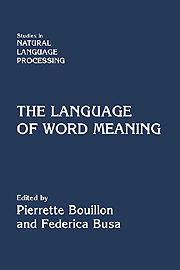Book contents
- Frontmatter
- Contents
- List of Contributors
- Preface
- Introduction: Word Meaning and Creativity
- Part I Linguistic Creativity and the Lexicon
- Part II The Syntax of Word Meaning
- Part III Interfacing the Lexicon
- 13 Introduction
- 14 Metaphor, Creative Understanding, and the Generative Lexicon
- 15 Metaphor in Discourse
- 16 Syntax and Metonymy
- 17 Generative Lexicon Meets Corpus Data: The Case of Nonstandard Word Uses
- Part IV Building Resources
- Index
15 - Metaphor in Discourse
Published online by Cambridge University Press: 07 October 2011
- Frontmatter
- Contents
- List of Contributors
- Preface
- Introduction: Word Meaning and Creativity
- Part I Linguistic Creativity and the Lexicon
- Part II The Syntax of Word Meaning
- Part III Interfacing the Lexicon
- 13 Introduction
- 14 Metaphor, Creative Understanding, and the Generative Lexicon
- 15 Metaphor in Discourse
- 16 Syntax and Metonymy
- 17 Generative Lexicon Meets Corpus Data: The Case of Nonstandard Word Uses
- Part IV Building Resources
- Index
Summary
Abstract
In this paper, we offer a novel analysis of metaphor, which attempts to capture both their conventional constraints on their meaning, and the ways in which information in the discourse context contributes to their interpretation in context. We make use of lexical rules in a constraint-based grammar to do the former task, and a formal semantics of discourse, where coherence constraints are defined in terms of discourse structure, to do the latter task. The two frameworks are linked together, to produce an analysis of metaphor that both defines what's linguistically possible and accounts for the ways in which pragmatic clues from domain knowledge and rhetorical structure influence the meaning of metaphor in context.
Introduction
This paper focuses on metaphor and the interpretation of metaphor in a discourse setting. We propose constraints on their interpretation in terms of linguistic structures. Specifically, the constraints are based on a particular conception of the lexicon, where lexical entries have rich internal structure, and derivational processes or productivity between word senses are captured in a formal, systematic way (e.g., Copestake and Briscoe, 1995; Pustejovsky, 1995). By constraining metaphor in terms of these linguistic structures, we show that their interpretation is not purely a psychological association problem (cf. Lakoff and Johnson, 1980), or purely subjective (e.g., Davidson, 1984). Recent accounts of metaphor within philosophy have not given systematic accounts of this sort (e.g., Black, 1962; Hesse, 1966; Searle, 1979). We leave open the question of whether their insights are compatible with the theory proposed here.
- Type
- Chapter
- Information
- The Language of Word Meaning , pp. 262 - 289Publisher: Cambridge University PressPrint publication year: 2001
- 10
- Cited by



